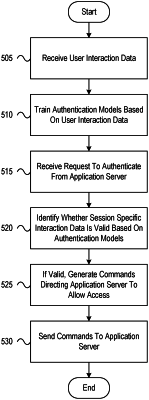| CPC H04L 63/08 (2013.01) [G06N 20/00 (2019.01); H04L 63/1416 (2013.01)] | 16 Claims |

|
1. A computing platform, comprising:
at least one processor;
a communication interface communicatively coupled to the at least one processor; and
memory storing computer-readable instructions that, when executed by the at least one processor, cause the computing platform to:
receive, via the communication interface, from enterprise computing infrastructure, user interaction data;
train, using a machine learning engine, one or more authentication models based on the user interaction data, wherein training the one or more authentication models based on the user interaction data comprises training at least one user-specific model for a first user and wherein training the at least one user-specific model for the first user comprises training a first user-specific model based on interaction data associated with at least two different user interaction channels including at least two of: an online banking channel, a mobile banking channel, and an interactive voice response channel;
receive, from a first application server associated with the enterprise computing infrastructure, a request to authenticate a first user to a first user account in a first usage session hosted by the first application server;
in response to receiving the request to authenticate the first user to the first user account, identify whether session-specific interaction data for the first usage session is valid based on the one or more authentication models, identifying whether session-specific interaction data for the first usage session is valid based on the one or more authentication models including:
identifying one or more parameters of the one or more authentication model;
calculating one or more distance values between an expected value of a parameter in the one or more authentication models and a measured value of the parameter in the session-specific interaction data; and
comparing the calculated one or more distance values to one or more threshold values to determine whether the calculated one or more distance values are within a permitted range indicating that the session-specific interaction data is valid; and
based on identifying that the session-specific interaction data for the first usage session is valid based on the one or more authentication models:
generate one or more commands directing the first application server to allow the first user to access the first user account in the first usage session hosted by the first application server;
send, to the first application server, the one or more commands directing the first application server to allow the first user to access the first user account in the first usage session hosted by the first application server, wherein sending the one or more commands directing the first application server to allow the first user to access the first user account in the first usage session hosted by the first application server causes the first application server to allow the first user to access the first user account in the first usage session hosted by the first application server;
after identifying whether the session-specific interaction data for the first usage session is valid based on the one or more authentication models:
detect a disruption in a marketplace;
receive, responsive to the detected disruption in the marketplace and via the communication interface, from an enterprise user computing device, one or more dynamic adjustment commands to adjust at least one of: an effectiveness rating of the one or more authentication models or an accuracy rating of the one or more authentication models; and
in response to receiving the one or more dynamic adjustment commands from the enterprise user computing device, adjust the at least one of: the effectiveness rating of the one or more authentication models or the accuracy rating of the one or more authentication models based on the one or more dynamic adjustment commands received from the enterprise user computing device;
receive, via the communication interface, from the enterprise computing infrastructure, updated user interaction data; and
re-train, using the machine learning engine, the one or more authentication models based on the updated user interaction data, wherein the updated user interaction data is captured from a limited time window and disregards user interaction data beyond a predetermined age.
|